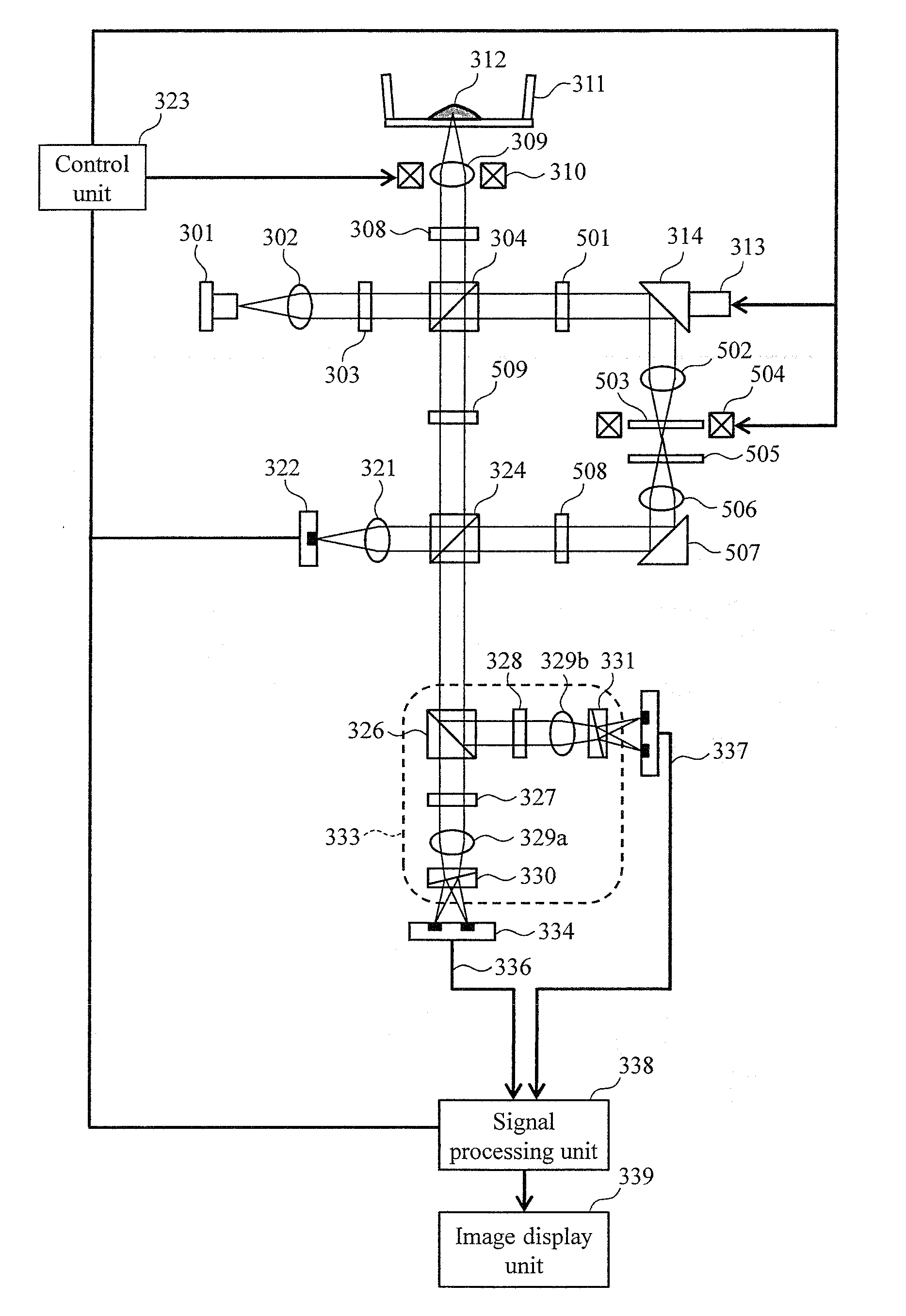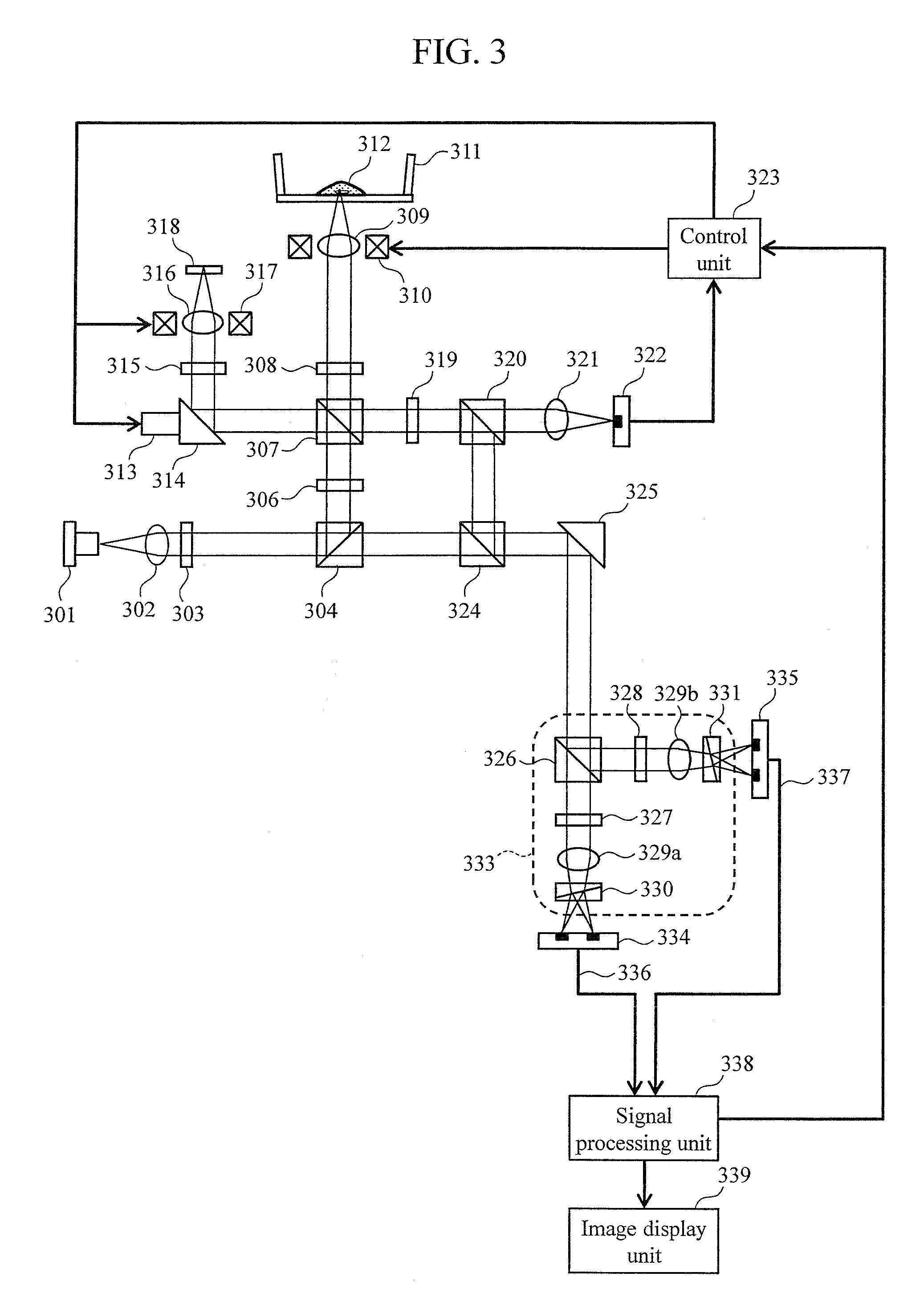Optical measurement apparatus
- Summary
- Abstract
- Description
- Claims
- Application Information
AI Technical Summary
Benefits of technology
Problems solved by technology
Method used
Image
Examples
embodiment 1
[0036]FIG. 3 is a schematic view showing the basic embodiment of the optical measurement apparatus of the present invention.
[0037]A laser beam is emitted from a light source 301. The laser beam is converted into a collimated beam by a collimator lens 302, and is subjected to polarization rotation by a λ / 2 plate 303 capable of adjusting the optical axis direction, and is further split into two by a polarization beam splitter 304. One of the light beams split by the polarization beam splitter 304 becomes incident on a polarization beam splitter 324 as a reference beam. The other of the light beams split by the polarization beam splitter 304 is subjected to polarization rotation by a λ / 2 plate 306 capable of adjusting the optical axis direction, and is then split into two: a signal beam and a control beam by a polarization beam splitter 307.
[0038]The signal beam passes through a λ / 4 plate 308 at which the optical axis is set to about 22.5° with respect to the horizontal direction, and ...
embodiment 2
[0075]FIG. 6 is a schematic view showing another embodiment of the optical measurement apparatus of the present invention. It should be noted that component parts that are identical to those shown in FIG. 3 are denoted by identical reference numerals, and detailed description thereof will be omitted. This embodiment differs from the first embodiment in the method of generating a control beam and the method of adjusting defocus of the control beam.
[0076]A laser beam is emitted from the light source 301. The laser beam is converted into a collimated beam by a collimator lens 302, and is subjected to polarization rotation by a λ / 2 plate 303 capable of adjusting the optical axis direction, and is further split into two by a polarization beam splitter 304. One of the light beams split by the polarization beam splitter 304 passes through a λ / 4 plate 308 at which the optical axis is set to about 22.5° with respect to the horizontal direction, as a signal beam, and thus is converted from th...
embodiment 3
[0084]FIG. 7 is a schematic view showing another embodiment of an optical measurement apparatus in accordance with the present invention. It should be noted that component parts that are identical to those shown in FIG. 3 are denoted by identical reference numerals, and detailed description thereof will be omitted. This embodiment differs from Embodiment 2 in that two interference beams are generated by interference optics, and a piezoelectric element for rapidly modulating the phase of a reference beam is used.
[0085]This embodiment is substantially similar to Embodiment 2 up to a configuration in which a laser beam is emitted from a light source 301 and a controlled signal beam is combined with a reference beam to generate a combined beam. However, this embodiment differs from Embodiment 2 in that a mirror 507 is mounted on a piezoelectric element 601 for rapidly modulating the phase of the reference beam. The combined beam is guided to interference optics 602 that include a λ / 2 pl...
PUM
 Login to View More
Login to View More Abstract
Description
Claims
Application Information
 Login to View More
Login to View More - R&D
- Intellectual Property
- Life Sciences
- Materials
- Tech Scout
- Unparalleled Data Quality
- Higher Quality Content
- 60% Fewer Hallucinations
Browse by: Latest US Patents, China's latest patents, Technical Efficacy Thesaurus, Application Domain, Technology Topic, Popular Technical Reports.
© 2025 PatSnap. All rights reserved.Legal|Privacy policy|Modern Slavery Act Transparency Statement|Sitemap|About US| Contact US: help@patsnap.com



